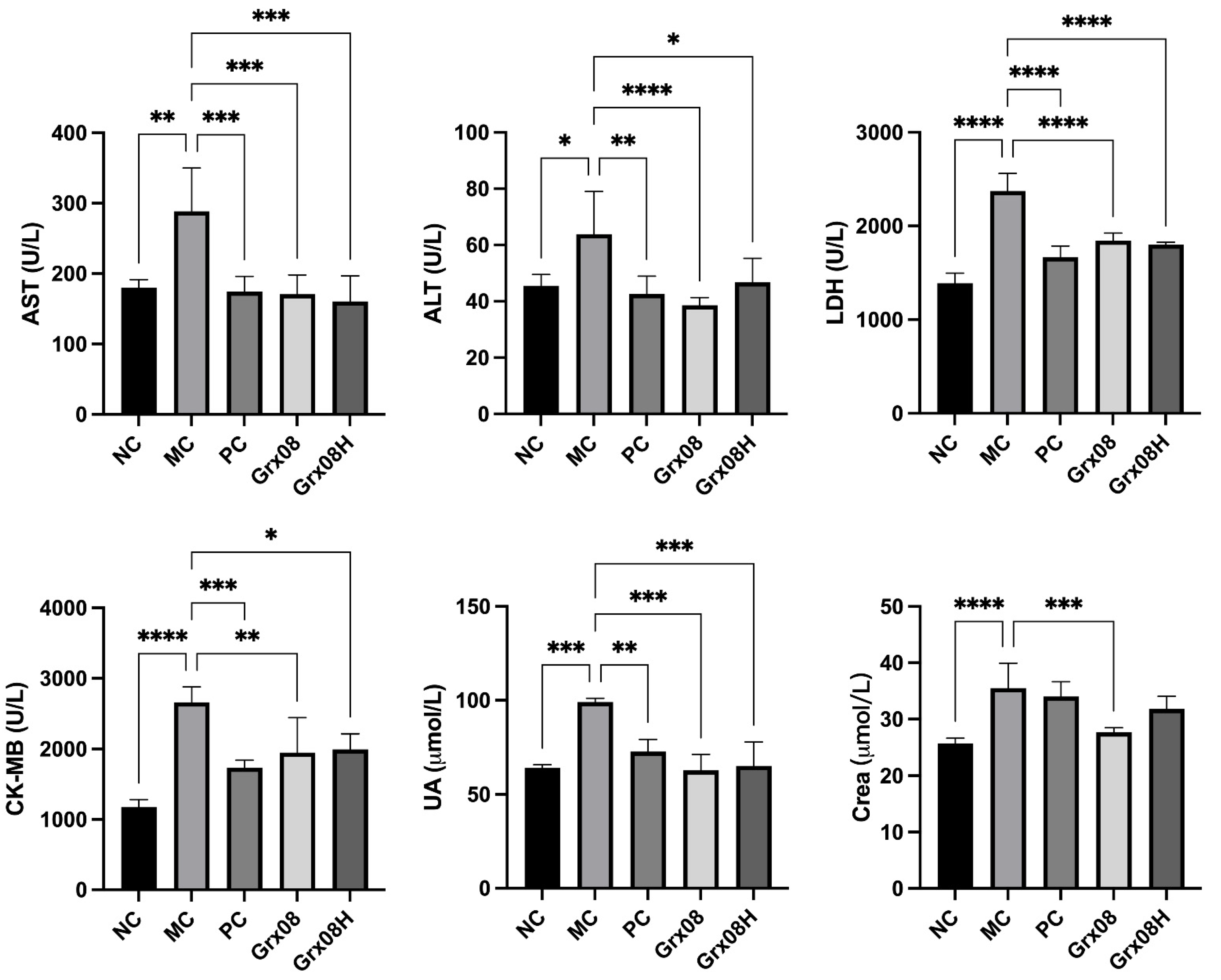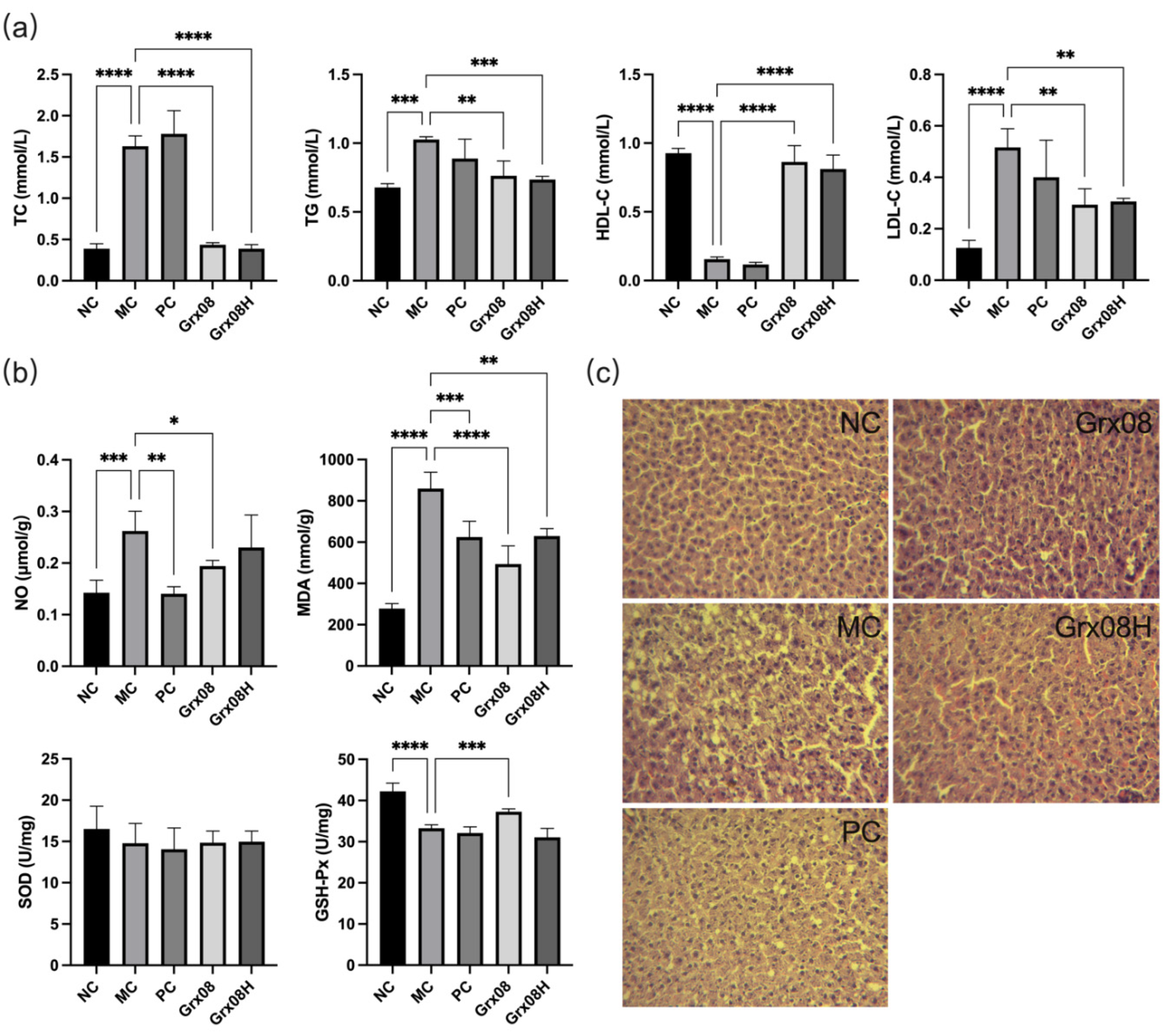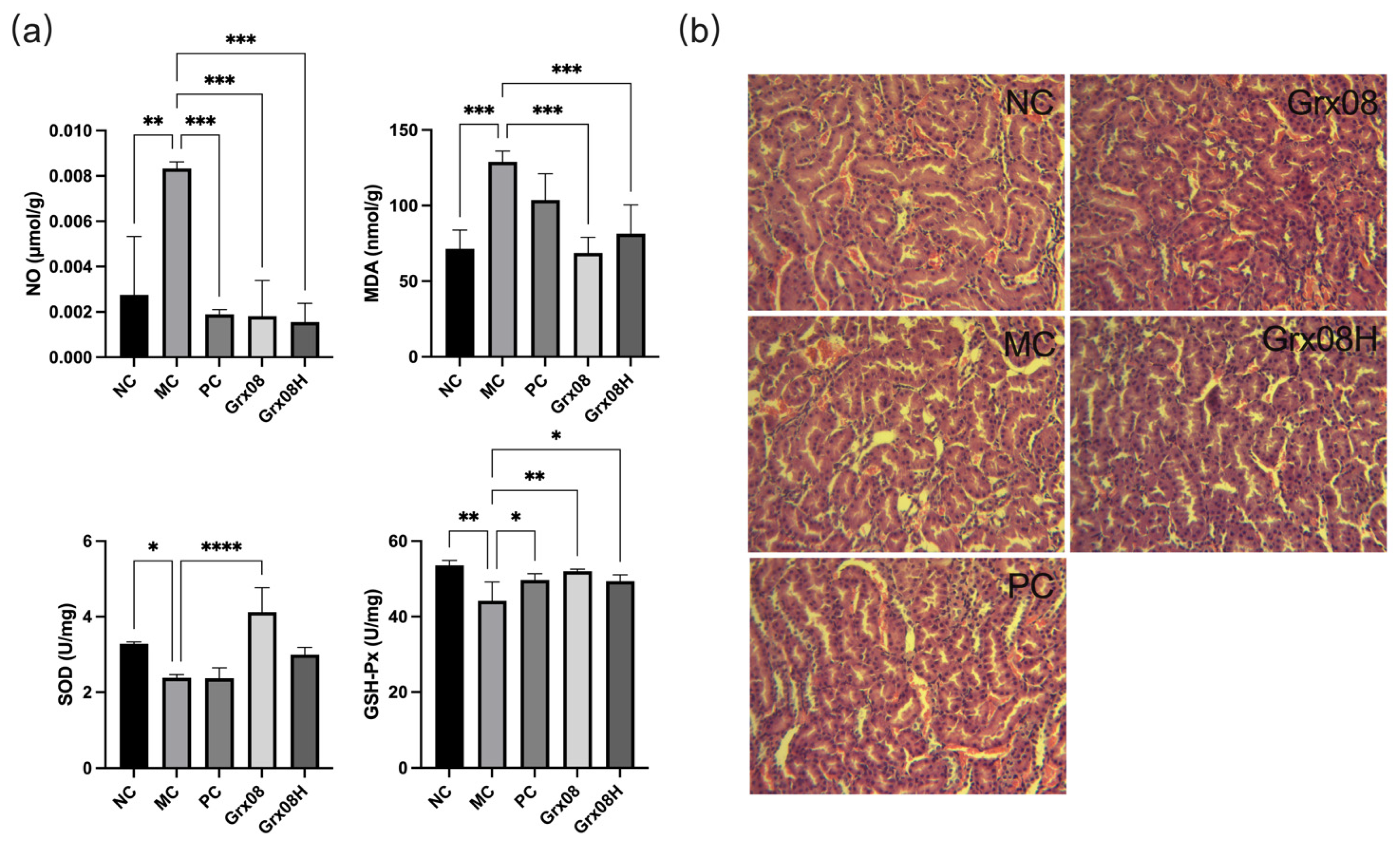Modulatory Effect of Limosilactobacillus fermentum grx08 on the Anti-Oxidative Stress Capacity of Liver, Heart, and Kidney in High-Fat Diet Rats
Abstract
1. Introduction
2. Materials and Methods
2.1. Microorganism and Preparation of Oral Samples
2.2. Animals and Treatment
2.3. Body Weight and Organ Index
2.4. Blood Samples Handling
2.5. Organ Samples Handling
2.6. Indicator Testing
2.7. Statistical Methods
3. Result
3.1. Effect of L. fermentum grx08 on Body Weight and Organ Index of Rats
3.2. Effect of L. fermentum grx08 on Organ Oxidative Stress Injuries
3.3. Modulatory Effect of L. fermentum grx08 on Anti-Oxidative Stress of Rat Liver
3.4. Modulatory Effect of L. fermentum grx08 on Anti-Oxidative Stress of Rat Heart
3.5. Modulatory Effect of L. fermentum grx08 on Anti-Oxidative Stress of Rat Kidney
4. Discussion
5. Conclusions
Author Contributions
Funding
Institutional Review Board Statement
Informed Consent Statement
Data Availability Statement
Conflicts of Interest
References
- Tian, J.L.; Gomeshtapeh, F.I. Potential roles of O-GlcNAcylation in primary cilia—Mediated energy metabolism. Biomolecules 2020, 10, 1504. [Google Scholar] [CrossRef] [PubMed]
- Enkhmaa, B.; Anuurad, E.; Berglund, L. Lipoprotein (a): Impact by ethnicity and environmental and medical conditions. J. Lipid Res. 2016, 57, 1111–1125. [Google Scholar] [CrossRef] [PubMed]
- Pennisi, E.M.; Garibaldi, M.; Antonini, G. Lipid Myopathies. J. Clin. Med. 2018, 7, 472. [Google Scholar] [CrossRef] [PubMed]
- Mikolasevic, I.; Milic, S.; Wensveen, T.T.; Grgic, I.; Jakopcic, I.; Stimac, D.; Wensveen, F.; Orlic, L. Nonalcoholic fatty liver disease—A multisystem disease? World J. Gastroenterol. 2016, 22, 9488–9505. [Google Scholar] [CrossRef] [PubMed]
- Chen, D.; Yang, Z.; Chen, X.; Huang, Y.; Yin, B.; Guo, F.; Zhao, H.; Zhao, T.; Zhenquan, Y.; Huang, J.; et al. The effect of Lactobacillus rhamnosus hsryfm 1301 on the intestinal microbiota of a hyperlipidemic rat model. BMC Complement. Altern. Med. 2014, 14, 386. [Google Scholar] [CrossRef] [PubMed]
- Qu, H.; Yu, H.; Gu, R.; Chen, D.; Chen, X.; Huang, Y.; Xi, W.; Huang, Y. Proteomics for studying the effects of L. rhamnosus LV108 against non-alcoholic fatty liver disease in rats. RSC Adv. 2018, 8, 38517–38528. [Google Scholar] [CrossRef] [PubMed]
- Huang, Y.; Qu, H.; Liu, D.; Wa, Y.; Sang, J.; Yin, B.; Chen, D.; Chen, X.; Gu, R. The effect of Lactobacillus fermentum DALI02 in reducing the oxidative stress and inflammatory response induced by high-fat diet of rats. RSC Adv. 2020, 10, 34396–34402. [Google Scholar] [CrossRef] [PubMed]
- Garcia, F.; Gonzaga, G.; Muñoz-Jiménez, I.; Blas-Marron, M.G.; Silverio, O.; Tapia, E.; Soto, V.; Ranganathan, N.; Ranganathan, P.; Vyas, U.; et al. Probiotic supplements prevented oxonic acid-induced hyperuricemia and renal damage. PLoS ONE 2018, 13, e0202901. [Google Scholar] [CrossRef]
- Chan, Y.K.; Brar, M.S.; Kirjavainen, P.V.; Chen, Y.; Peng, J.; Li, D.; Leung, F.C.-C.; El-Nezami, H. High fat diet induced atherosclerosis is accompanied with low colonic bacterial diversity and altered abundances that correlates with plaque size, plasma A-FABP and cholesterol: A pilot study of high fat diet and its intervention with Lactobacillus rhamnosus GG (LGG) or telmisartan in ApoE(-/-) mice. BMC Microbiol. 2016, 16, 264. [Google Scholar] [CrossRef]
- Schoemaker, M.H.; Kleemann, R.; Morrison, M.C.; Verheij, J.; Salic, K.; van Tol, E.A.F.; Kooistra, T.; Wielinga, P.Y. A casein hydrolysate based formulation attenuates obesity and associated non-alcoholic fatty liver disease and atherosclerosis in LDLr-/-.Leiden mice. PLoS ONE 2017, 12, e0180648. [Google Scholar] [CrossRef] [PubMed]
- Wa, Y.; Yin, B.; He, Y.; Xi, W.; Huang, Y.; Wang, C.; Guo, F.; Gu, R. Effects of single probiotic- and combined probiotic-fermented milk on lipid metabolism in hyperlipidemic rats. Front. Microbiol. 2019, 10, 1312. [Google Scholar] [CrossRef]
- Al-Busafi, S.A.; Hilzenrat, N. Mild hypertransaminasemia in primary care. ISRN Hepatol. 2013, 2013, 256426. [Google Scholar] [CrossRef]
- Van Wilpe, S.; Koornstra, R.; Den Brok, M.; De Groot, J.W.; Blank, C.; De Vries, J.; Gerritsen, W.; Mehra, N. Lactate dehydrogenase: A marker of diminished antitumor immunity. Oncoimmunology 2020, 9, 1731942. [Google Scholar] [CrossRef]
- Dhamecha, D.; Jalalpure, S.; Jadhav, K.; Jagwani, S.; Chavan, R. Doxorubicin loaded gold nanoparticles: Implication of passive targeting on anticancer efficacy. Pharmacol. Res. 2016, 113, 547–556. [Google Scholar] [CrossRef] [PubMed]
- Abou-Elela, A. Epidemiology, pathophysiology, and management of uric acid urolithiasis: A narrative review. J. Adv. Res. 2017, 8, 513–527. [Google Scholar] [CrossRef] [PubMed]
- Becker, M.; Gnirck, A.-C.; Turner, J.-E. Innate lymphoid cells in renal inflammation. Front. Immunol. 2020, 11, 72. [Google Scholar] [CrossRef] [PubMed]
- Mularczyk, M.; Michalak, I.; Marycz, K. Astaxanthin and other Nutrients from haematococcus pluvialis-multifunctional applications. Mar. Drugs 2020, 18, 459. [Google Scholar] [CrossRef] [PubMed]
- Lorente, L.; Aller, M.-A.; Arias, J.-L.; Arias, J. Nitric oxide (NO) is a highly reactive free radical with a multitude of organ specific regulatory functions. Ann. Surg. 1996, 224, 688–689. [Google Scholar] [CrossRef] [PubMed]
- Ayala, A.; Muñoz, M.F.; Argüelles, S. Lipid peroxidation: Production, metabolism, and signaling mechanisms of malondialdehyde and 4-hydroxy-2-nonenal. Oxidative Med. Cell. Longev. 2014, 2014, 360438. [Google Scholar] [CrossRef] [PubMed]
- Hess, J.A.; Khasawneh, M.K. Cancer metabolism and oxidative stress: Insights into carcinogenesis and chemotherapy via the non-dihydrofolate reductase effects of methotrexate. BBA Clin. 2015, 3, 152–161. [Google Scholar] [CrossRef] [PubMed]




| Initial Weight (g) | Final Weight (g) | Liver | Heart | Kidney | |
|---|---|---|---|---|---|
| NC | 145.00 ± 7.97 | 352.80 ± 12.07 * | 3.53 ± 0.04 * | 0.29 ± 0.02 | 0.67 ± 0.03 |
| MC | 146.50 ± 12.26 | 415.25 ± 17.73 | 4.54 ± 0.05 | 0.28 ± 0.02 | 0.59 ± 0.03 |
| PC | 147.00 ± 8.52 | 375.50 ± 12.07 * | 4.49 ± 0.05 | 0.32 ± 0.02 | 0.62 ± 0.06 |
| Grx08 | 143.20 ± 4.32 | 358.80 ± 22.99 * | 3.89 ± 0.03 * | 0.28 ± 0.01 | 0.57 ± 0.04 |
| Grx08H | 145.40 ± 5.41 | 384.60 ± 37.42 | 4.19 ± 0.03 * | 0.32 ± 0.03 | 0.59 ± 0.05 |
Publisher’s Note: MDPI stays neutral with regard to jurisdictional claims in published maps and institutional affiliations. |
© 2022 by the authors. Licensee MDPI, Basel, Switzerland. This article is an open access article distributed under the terms and conditions of the Creative Commons Attribution (CC BY) license (https://creativecommons.org/licenses/by/4.0/).
Share and Cite
Qu, H.; Zhang, L.; Liu, X.; Liu, Y.; Mao, K.; Shen, G.; Wa, Y.; Chen, D.; Huang, Y.; Chen, X.; et al. Modulatory Effect of Limosilactobacillus fermentum grx08 on the Anti-Oxidative Stress Capacity of Liver, Heart, and Kidney in High-Fat Diet Rats. Fermentation 2022, 8, 594. https://doi.org/10.3390/fermentation8110594
Qu H, Zhang L, Liu X, Liu Y, Mao K, Shen G, Wa Y, Chen D, Huang Y, Chen X, et al. Modulatory Effect of Limosilactobacillus fermentum grx08 on the Anti-Oxidative Stress Capacity of Liver, Heart, and Kidney in High-Fat Diet Rats. Fermentation. 2022; 8(11):594. https://doi.org/10.3390/fermentation8110594
Chicago/Turabian StyleQu, Hengxian, Longfei Zhang, Xiaoxiao Liu, Yang Liu, Kaidong Mao, Guiqi Shen, Yunchao Wa, Dawei Chen, Yujun Huang, Xia Chen, and et al. 2022. "Modulatory Effect of Limosilactobacillus fermentum grx08 on the Anti-Oxidative Stress Capacity of Liver, Heart, and Kidney in High-Fat Diet Rats" Fermentation 8, no. 11: 594. https://doi.org/10.3390/fermentation8110594
APA StyleQu, H., Zhang, L., Liu, X., Liu, Y., Mao, K., Shen, G., Wa, Y., Chen, D., Huang, Y., Chen, X., & Gu, R. (2022). Modulatory Effect of Limosilactobacillus fermentum grx08 on the Anti-Oxidative Stress Capacity of Liver, Heart, and Kidney in High-Fat Diet Rats. Fermentation, 8(11), 594. https://doi.org/10.3390/fermentation8110594






